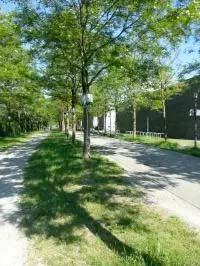 Study on the cooling effect of black locust and linden trees in from Technical Univ. of Munich
Study on the cooling effect of black locust and linden trees in from Technical Univ. of Munich
Trees cool the environment; however, the degree of cooling depends greatly on the tree species and the local conditions. In a recent study, scientists at the Technical University of Munich (TUM) compared two species of urban trees – the black locust and linden.
It is cooler under black locusts, especially on hot summer days. This has significant implications for landscape architecture and urban planning: “Tree species such as the black locust that consume little water can provide a higher cooling effect if they are planted on grass lawns,” Dr. Mohammad Rahman from TUM explained. “The surrounding soil remains moister thanks to the trees; the grass dissipates additional heat through the evaporation of water and thus reduces the temperature near the ground.”
A Look Under the Treetops
Trees are considered to be nature’s air conditioners, making them the most practical way of alleviating the heat. With the little-leaved linden and the black locust the TUM research team selected these two popular but contrasting urban tree species to analyze the complex interplay of location factors, current weather conditions, and tree type. In light of climate change, the focus was on the cooling effect on very hot days.
The analysis by the research team becomes clearer by comparison: The output of a mechanical air conditioner is between one and ten kilowatts (kW) that of a linden tree up to 2.3 kW. This cooling capacity is fed by various processes such as their dense treetops that provide shade. Or the fact that the leaf surfaces reflect the short-wave rays of the sun and also use them for transpiration.
These cooling mechanisms are common in all plants including grass. However, with bigger and denser canopies along with higher water loss from the stomata of their leaves, linden trees use a large percentage of the intercepted radiation to vaporize them, hence cooling the surrounding micro-climate better.
However, there are several differences to the luxuriantly blooming black locust: Its crown is less dense, the leaf surface is smaller, and hence the transpiration is lower. That makes the linden tree more effective when it comes to cooling on mild summer days. However, the black locust needs less water than the linden tree, which takes more water out of the soil during the high heat. Therefore in case of grass lawns additional cooling function from the grass surfaces under black locust trees seem more effective. With the climate change and accelerating drought either we have to water the grass lawns for having higher cooling effect under the tree species such as linden or less water demanding species need to be found. On the other hand, for paved surfaces better cooling from the dense shade of linden trees are more effective.
